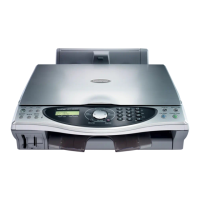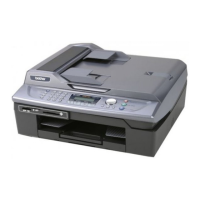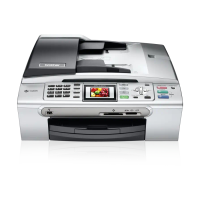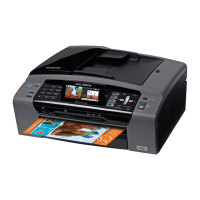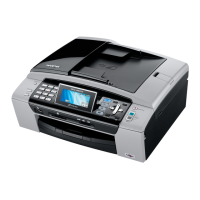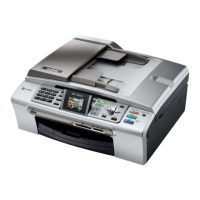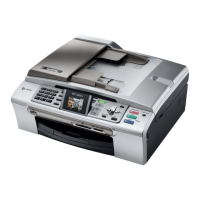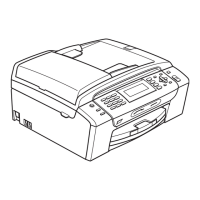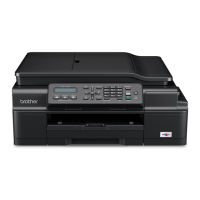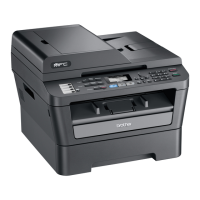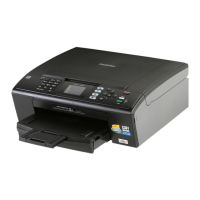On-Screen Programming Page: 45 General Setup Menu Details on setting Paper Type, Date/Time, Station ID, Ring Volume, Beeper Volume, and Speaker Volume.
Fax;Tel Menu Configuration options for receiving faxes and telephone calls, including receive modes and ring delay.
Setup Send Menu Settings related to sending faxes, including contrast, resolution, timer, and batch transmission.
Set Quick-Dial Options for setting up speed dial numbers and groups for broadcasting faxes.
Remote Fax Options Features for managing fax messages remotely, including forwarding, storage, and access codes.
Setup TAD Settings for the Telephone Answering Device (TAD) mode, including OGM and maximum message time.
Copy Menu Settings for copying, including quality, brightness, and contrast adjustments.
Maintenance Menu Options for printer maintenance such as test print, cleaning, and ink volume check.
Print Reports Options for printing various reports like Help, Quick Dial, Journal, and System Setup.
Walk-Up PhotoCapture Center Page: 148 Basic flow Steps for using PhotoCapture Center: inserting media, printing index, and printing images.
Getting started Instructions for inserting media cards (CompactFlash®, SmartMedia®, Memory Stick®) into the MFC.
Printing images Steps to print individual images by entering their numbers from the Index page.
Paper Type Selecting the paper type for printing images to ensure best print quality.
Print Quality Selecting print quality settings (Normal, Fine, or Photo) for printing images.
Colour Enhancement Enabling Colour Enhancement to print more vivid images and customize settings.
Changing the default settings Adjusting default settings for Print Quality, Print Size, Brightness, Contrast, Colour Enhancement, and Scan to Card.
Printer driver settings Page: 172 Basic tab Configuration options on the Basic tab, including Media Type, Quality, Paper Size, and Orientation.
Media Type Selecting the media type in the driver for optimal print results.
Quality Choosing print resolution (Photo, S.Fine, Fine, Normal, Fast) based on media type.
Colour Adjusting colour settings, including Colour/Greyscale and Image Type (Auto, Photo, Graphics, Custom).
Colour Enhancement Enabling colour enhancement to improve image quality, sharpness, white balance, and colour density.
How to scan using Windows Page: 193 Scanning a whole page Steps for scanning a whole page, including placing the original and adjusting settings.
Resolution Changing scanning resolution, noting that higher resolutions use more memory and transfer time.
Scan Type Setting Scan Type to Black & White, Grey Scale, or Colours (256 or 24-bit).
Color Type Setting Image Type to Black & White, Gray (Error Diffusion), True Gray, or Colors.
Using the Brother Control Center for Windows 98; 98 SE;Me;2000 Professional Page: 218 Scan to File Configuring Scan to File to save scanned images to a specific file type and directory.
Scan to E-mail Configuring Scan to E-mail feature for saving scans as file attachments to an email application.
Scanner settings Selecting scanning modes for file types like Text for OCR, Photos, and Custom.
Scan Image Configuring Scan to Image feature, including destination application and scanner settings.
File Selecting file format and destination directory for scanned files.
OCR Selecting destination word processor and OCR application for scanned documents.
E-mail Selecting destination E-mail application and configuring Send To E-mail options.
Select Scan Settings Selecting scanner settings like Color Mode, Resolution, Paper Size, Brightness, and Contrast for custom buttons.
Specifications Page: 349 General General specifications including memory capacity, paper tray, printer type, LCD, operating environment, and power.
Print media Details on paper input and output for the paper tray, including paper types and sizes.
Copy Specifications for copy functions, including colour/mono, copy speed, enlarge/reduce, and resolution.
Photo Capture Center Specifications for Photo Capture Center, including available media, file extension, number of files, and folder structure.
Fax Specifications related to fax functionality, including compatibility, coding, modem speed, and resolution.
Scanner Specifications for the scanner, including colour/mono, TWAIN compliance, resolution, and scanning speed.
Printer Specifications for the printer, including driver compatibility, resolution, print speed, and paper handling.
